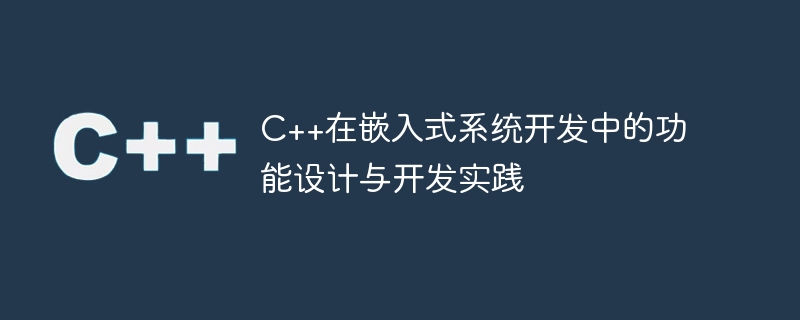

C Functional design and development practice in embedded system development
Embedded systems refer to being embedded in other devices or systems and used to complete specific tasks computer system. The development of embedded systems requires an in-depth understanding of hardware, software and systems, and the ability to correctly control and manage each module in the system. In the development process of embedded systems, C is a commonly used programming language, which can provide higher-level abstraction and object-oriented design ideas to facilitate system development and maintenance. This article will introduce the functional design and development practices of C in embedded system development and give some code examples.
1. Functional design
In the development of embedded systems, functional design is a very important link. Through functional design, we can clarify the functional modules of the system and the relationships between them, thereby providing guidance for the subsequent development process of the system. In C, we can use object-oriented design ideas for functional design.
Object-oriented design thinking can abstract the system into a set of interrelated objects, each object has its own properties and behaviors. By defining classes and objects, we can divide the functional modules of the system into different classes, and describe the dependencies and interactions between modules through the relationships between classes. For example, in an embedded system, you can define a GPIO class to describe the operation of the GPIO interface, and a UART class to describe the functions of serial communication, etc.
The following is a simple example that describes the control of an LED through classes.
class LED {
public:
void turnOn() {
// 对应的硬件操作代码
}
void turnOff() {
// 对应的硬件操作代码
}
};By defining the LED class, we can call the turnOn() and turnOff() methods to control the on/off state of the LED. This object-oriented design idea can encapsulate the functional modules of the system, making the system design more flexible and maintainable.
2. Development Practice
In the development practice of embedded systems, C can help us better manage various modules in the system. Below are two practical cases of C in embedded system development.
Device drivers are an important part of embedded systems. In C, we can use classes to encapsulate device driver related operations. For example, to drive an LCD display in an embedded system, you can define an LCD class to perform related operations.
class LCD {
public:
void init() {
// LCD初始化相关操作
}
void display(const char* content) {
// 在LCD上显示内容
}
};By defining the LCD class, we can directly call the init() and display() methods in other modules of the system to perform related operations without knowing the specific implementation details.
In embedded systems, it is often necessary to deal with various data structures and algorithms. The C Standard Template Library (STL) can provide rich data structures and algorithm implementations to facilitate developers in system development. For example, we can use STL's vector class as a dynamic array, use STL's sort function for sorting, etc.
#include#include int main() { std::vector numbers = {1, 3, 2, 4, 5}; std::sort(numbers.begin(), numbers.end()); // 打印排序结果 for (int number : numbers) { std::cout << number << " "; } return 0; }
By using STL, we can easily handle various data structures and algorithms and improve development efficiency.
Summary:
In embedded system development, C can provide higher-level abstraction and object-oriented design ideas to facilitate system functional design and development practice. By rationally using C's features and library functions, we can better manage various modules in the system and improve development efficiency.
(Note: The above code examples are only for demonstration and explanation. Actual embedded system development requires appropriate adjustments and modifications based on the specific hardware platform and development environment.)
The above is the detailed content of Functional design and development practice of C++ in embedded system development. For more information, please follow other related articles on the PHP Chinese website!
 How to solve website restore error
How to solve website restore error
 Google account registration method
Google account registration method
 Windows cannot find the solution to the certificate
Windows cannot find the solution to the certificate
 OuYi exchange usdt price
OuYi exchange usdt price
 How to solve the problem that pycharm cannot find the module
How to solve the problem that pycharm cannot find the module
 Merge cell fill sequence number
Merge cell fill sequence number
 How to restore Bluetooth headset to binaural mode
How to restore Bluetooth headset to binaural mode
 The difference between export and export default
The difference between export and export default




